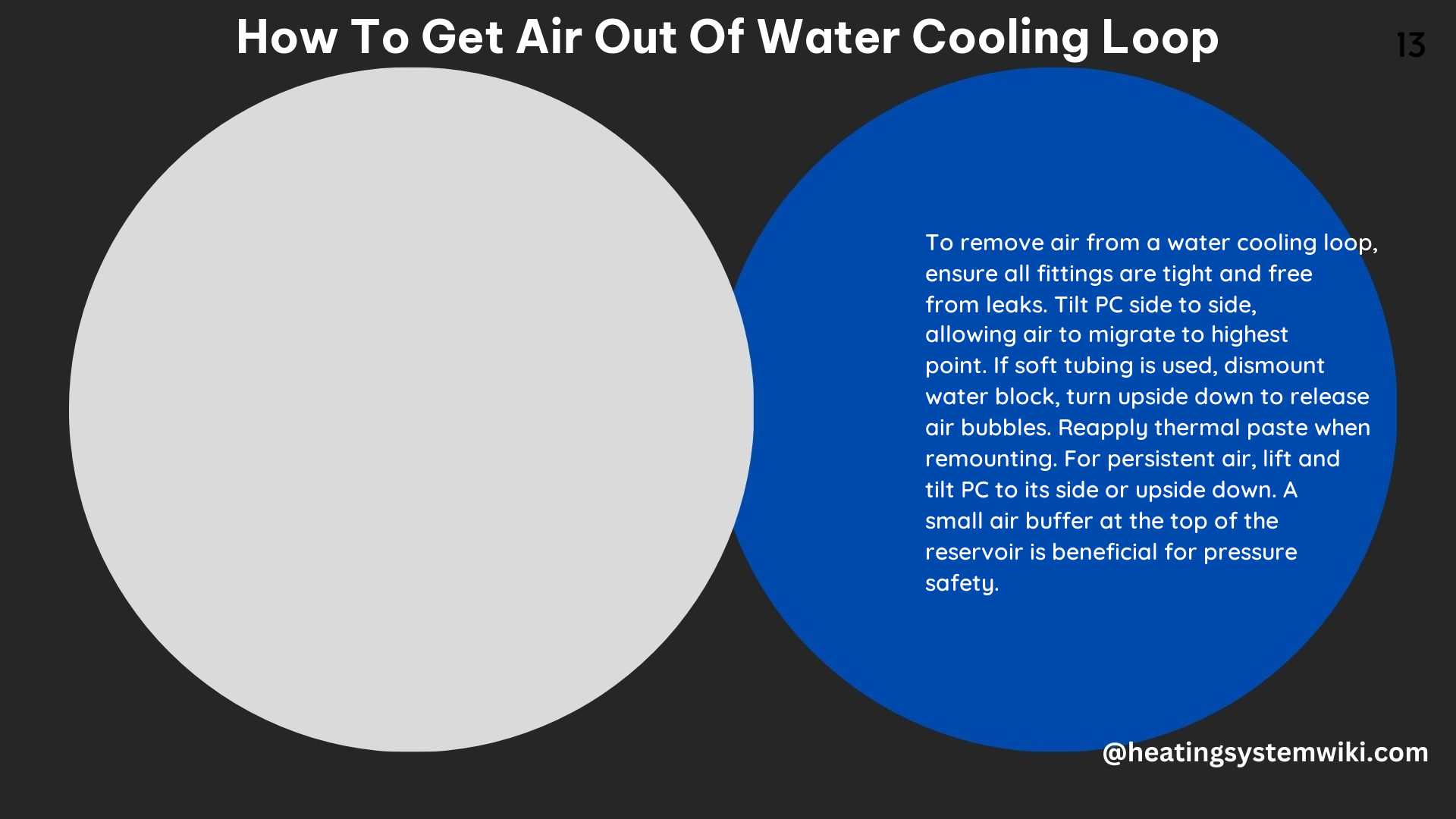Getting air out of a water cooling loop is a crucial step in ensuring the optimal performance and longevity of your system. Air bubbles can cause reduced cooling efficiency, increased pump noise, and even potential damage to your components. In this comprehensive guide, we’ll explore various techniques and best practices to effectively remove air from your water cooling loop.
Tilting and Rotating the PC
One of the most common methods to get air out of a water cooling loop is to tilt and rotate the PC. This process involves physically moving the system to transition the air bubbles to the highest point of the loop, where they can be easily removed.
- Tilt the PC: Gently tilt the PC to the left, right, forward, and backward, ensuring that the air bubbles move towards the fill port or the highest point of the loop.
- Rotate the PC: Carefully rotate the PC, turning it upside down or on its side, to allow the air bubbles to travel to the desired location.
- Repeat the process: Continue tilting and rotating the PC until you observe the air bubbles gathering at the highest point of the loop.
Checking Fittings and Connections

Ensuring that all the fittings and connections in your water cooling loop are tight and secure is crucial to preventing air from entering the system. Follow these steps to check your fittings:
- Visually inspect the fittings: Examine each fitting for any signs of looseness or potential leaks.
- Tighten the fittings: Using the appropriate tools, gently tighten each fitting, being careful not to overtighten and potentially damage the components.
- Check for leaks: After tightening the fittings, carefully inspect the loop for any signs of leakage, such as water droplets or damp areas.
Lifting and Turning the PC
In some cases, you may need to lift and turn the entire PC to effectively remove air from the water cooling loop. This method is particularly useful when dealing with stubborn air bubbles that refuse to move using the tilting and rotating technique.
- Lift the PC: Carefully lift the entire PC, ensuring that you have a secure grip and can safely maneuver it.
- Turn the PC: Slowly turn the PC over to its side or even upside down, allowing the air bubbles to travel to the highest point of the loop.
- Repeat the process: Continue turning and rotating the PC until you observe the air bubbles gathering at the desired location.
Dismounting the CPU Water Block
If you have a water cooling loop with soft tubing and some slack in the tubing, you can try dismounting the CPU water block to remove air bubbles.
- Dismount the CPU water block: Carefully remove the CPU water block from the CPU, ensuring that you have the necessary tools and follow the manufacturer’s instructions.
- Turn the water block upside down: With the water block removed, turn it upside down to allow any air bubbles to escape.
- Reapply thermal paste: When remounting the CPU water block, be sure to reapply a fresh layer of high-quality thermal paste to ensure optimal heat transfer.
Cycling the PSU On/Off
Another method to remove air from a water cooling loop is to cycle the power supply (PSU) on and off, ensuring that the pump never runs dry.
- Connect the pump and motherboard: Ensure that the pump and motherboard cables are connected to the PSU.
- Cycle the PSU: Turn the PSU on and off repeatedly, allowing the pump to cycle and the air bubbles to gather at the highest point of the loop.
- Remove air through the fill port: As the air bubbles gather at the highest point, you can remove them through the fill port.
Maintaining a Safety Buffer
It’s important to note that having a small amount of air at the top of your reservoir is not necessarily a problem. This air acts as a safety buffer, allowing for pressure fluctuations in the system without causing any performance issues.
However, if the air bubbles are present in the right part of the loop, they can continuously introduce new air bubbles due to the falling fluid, which can be detrimental to the system’s performance.
Conclusion
Removing air from a water cooling loop is a crucial step in maintaining the optimal performance and longevity of your system. By following the techniques outlined in this guide, including tilting and rotating the PC, checking fittings, lifting and turning the PC, dismounting the CPU water block, and cycling the PSU on/off, you can effectively eliminate air bubbles and ensure a well-functioning water cooling loop.
Remember to always exercise caution when working with water-cooled systems, and refer to the manufacturer’s instructions for specific guidance on your components. With patience and attention to detail, you can successfully get air out of your water cooling loop and enjoy the benefits of a well-maintained, high-performance system.
